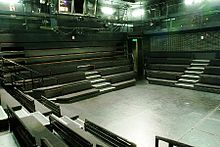

A theatre-in-the-round, arena theatre, or central staging is a space for theatre in which the audience surrounds the stage.
Theatre-in-the-round was common in ancient theatre, particularly that of Greece and Rome, but was not widely explored again until the latter half of the 20th century.
The Glenn Hughes Penthouse Theatre in Seattle, Washington was the first theatre-in-the-round venue built in the United States. It first opened on May 19, 1940, with a production of Spring Dance, a comedy by playwright Philip Barry.[1] The 160-seat theatre is located on the campus of the University of Washington in Seattle and is on the National Register of Historic Places.
In 1947, Margo Jones established America's first professional theatre-in-the-round company when she opened her Theater '47 in Dallas. The stage design as developed by Margo Jones was used by directors in later years for such well-known shows as Fun Home, the original stage production of Man of La Mancha, and all plays staged at the ANTA Washington Square Theatre (demolished in the 1960s), including Arthur Miller's autobiographical After the Fall. Such theatres had previously existed in colleges, but not in professional theatre buildings.
Theater-in-the-round is a particularly appropriate setting for staging of dramas using Bertolt Brecht's alienation effect,[2] which stands in opposition to the more traditional Stanislavski technique[3] in drama. Alienation techniques include visible lighting fixtures and other technical elements. Round theatres also allow lighting parts of the audience so that people are reminded that they are in a theatre watching a drama with others.
- ^ Tate, Cassandra. 200255. "Curtain rises on Seattle's new Penthouse Theatre on May 16, 1947." Archived August 8, 2016, at the Wayback Machine
- ^ Alienation Effect in Encyclopedia Britannica online.
- ^ The book "An Actor Prepares" was first published in 1936 and is the first volume of the translations of Constantin Stanislavski's books on acting, which were published as a trilogy in English, though originally meant to be published as two books in Russian.
